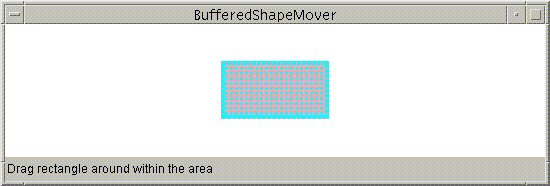When a graphic is complex or is used repeatedly, you can reduce the time it takes to display it by first rendering it to an off-screen buffer and then copying the buffer to the screen. This technique, called double buffering, is often used for animations.
Note: When you are rendering into a Swing component, Swing automatically double-buffers the display.A
BufferedImagecan easily be used as an off-screen buffer. To create aBufferedImagewhose color space, depth, and pixel layout exactly match the window into which you're drawing, call theComponentcreateImagemethod. If you need control over the off-screen image's type or transparency, you can construct aBufferedImageobject directly and use it as an off-screen buffer.To draw into the buffered image, you call the
BufferedImage createGraphicsmethod to get aGraphics2Dobject; then you call the appropriate rendering methods on theGraphics2D. All of the Java 2D API rendering features can be used when you're rendering to aBufferedImagethat's being used as an off-screen buffer.When you're ready to copy the
BufferedImageto the screen, you simply calldrawImageon your component'sGraphics2Dand pass in theBufferedImage.
Example: BufferedShapeMover
The following applet allows the user to drag a rectangle around within the applet window. Instead of rendering the rectangle at every mouse location to provide feedback as the user drags it, aBufferedImageis used as an off-screen buffer. As the rectangle is dragged, it is re-rendered into theBufferedImageat each new location and theBufferedImageis blitted to the screen.
This is a picture of the applet's GUI. To run the applet, click the picture. The applet will appear in a new browser window.The source code for the applet is in
BufferedShapeMover.java.Here is the code used to render into the
BufferedImageand display the image on the screen:public void updateLocation(MouseEvent e){ rect.setLocation(last_x + e.getX(), last_y + e.getY()); ... repaint(); ... // In the update method... if(firstTime) { Dimension dim = getSize(); int w = dim.width; int h = dim.height; area = new Rectangle(dim); bi = (BufferedImage)createImage(w, h); big = bi.createGraphics(); rect.setLocation(w/2-50, h/2-25); big.setStroke(new BasicStroke(8.0f)); firstTime = false; } // Clears the rectangle that was previously drawn. big.setColor(Color.white); big.clearRect(0, 0, area.width, area.height); // Draws and fills the newly positioned rectangle // to the buffer. big.setPaint(strokePolka); big.draw(rect); big.setPaint(fillPolka); big.fill(rect); // Draws the buffered image to the screen. g2.drawImage(bi, 0, 0, this); }
